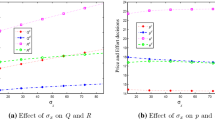Abstract
We study the benefits of coordinated decision making in a supply chain consisting of a manufacturer, a distributor, and several retailers. The distributor bundles finished goods produced by the manufacturer and delivers them to the retailers to meet their demands. The distributor is responsible for managing finished goods inventory. An optimal production schedule of the manufacturer, if imposed on the distributor, may result in an increased inventory holding cost for the distributor. On the other hand, an optimal distribution schedule of the distributor, if imposed on the manufacturer, may result in an increased production cost for the manufacturer. In this paper we develop mathematical models for individual optimization goals of the two partners and compare the results of these models with the results obtained for a joint optimization model at the system level. We investigate the computational complexities of these scheduling problems. The experimental results indicate that substantial cost savings can be achieved at the system level by joint optimization. We also study conflict and cooperation issues in the supply chain. The cost of conflict of a supply chain partner is a measure of the amount by which the unconstrained optimal cost increases when a decision is to be made under the scheduling constraint imposed by the other partner. We quantify these conflicts and show that the cost of conflicts are significant. We also show that a cooperative decision will generate a positive surplus in the system which can be shared by the two partners to make cooperation and coordination strategy more attractive.
Similar content being viewed by others
References
Agnetis, A., Hall, N. G., & Pacciarelli, D. (2006). Supply chain scheduling: Sequence coordination. Discrete Applied Mathematics, 154, 2044–2063.
Anupindi, R., & Akella, R. (1993). Diversification under supply uncertainty. Management Science, 39, 944–963.
Banker, R. D., & Khosla, I. S. (1995). Economics and operations management: A research perspective. Journal of Operations Management, 12, 423–435.
Blumenfeld, D. E., Burns, L. D., & Daganzo, C. F. (1991). Synchronizing production and transportation schedules. Transportation Research B, 25, 23–37.
Chandra, P., & Fisher, M. L. (1994). Coordination of production and distribution planning. European Journal of Operational Research, 72, 503–517.
Chang, Y.-C., & Lee, C.-Y. (2003). Logistics scheduling: Analysis of two-stage problems. Journal of Systems Science and Systems Engineering, 12, 385–407.
Chen, Z.-L., & Hall, N. G. (2008). Supply chain scheduling: Conflict and cooperation in assembly systems. Operations Research, to appear.
Chen, Z.-L., & Vairaktarakis, G. L. (2005). Integrated scheduling of production and distribution operations. Management Science, 51, 614–628.
Corfman, K. P., & Lehman, D. R. (1993). The importance of others’ welfare in evaluating bargaining outcomes. Journal of Consumer Research, 20, 124–137.
Dawande, M., Geismar, H. N., Hall, N. G., & Sriskandarajah, C. (2006). Supply chain scheduling: Distribution systems. Production and Operations Management, 15, 243–261.
Gardner, G. (1997). Production puzzle: Toyota rolls cars and minivans down the same line. In The ’98s ward’s auto world, October.
Garey, M. R., & Johnson, D. S. (1979). Computers and intractability: A guide to the theory of NP-completeness. San Francisco: Freeman.
Hall, N. G., & Potts, C. N. (2003). Supply chain scheduling: Batching and delivery. Operations Research, 51, 566–584.
Industrial Engineer (2005). Front Line: News, Trends and Tactics, 37(10), 14–15.
Karmarkar, U. S. (1996). Integrative research in marketing and operations management. Journal of Marketing Research, 33, 125–133.
Lee, C.-Y., & Chen, Z.-L. (2001). Machine scheduling with transportation considerations. Journal of Scheduling, 4, 3–24.
Lehman, D. (2001). The impact of altruism and envy on competitive behavior and satisfaction. International Journal of Research in Marketing, 18, 5–17.
Li, C.-L., & Xiao, W.-Q. (2004). Lot streaming with supplier-manufacturer coordination. Naval Research Logistics, 51, 522–542.
Muckstadt, J. A., & Roundy, R. O. (1993). Logistics of production and inventory. Handbooks in operations research and management science : Vol. 4. Amsterdamm: North-Holland.
Munson, C. L., Rosenblatt, M. J., & Rosenblatt, Z. (1999). The use and abuse of power in supply chains. Business Horizons, 42(1), 55–65.
Nash, J. F. (1953). Two-person cooperative games. Econometrica, 21, 128–140.
Nissan News (2005). http://www.nissannews.com/corporate/news/2005speeches/20050616120231.shtml.
Ohno, T. (1988). Toyota production system: Beyond large-scale production. Shelton: Productivity Press.
Ouchi, W. G. (1980). Markets, bureaucracies and clans. Administrative Science Quarterly, 25, 129–141.
Ow, P. S., Smith, S. F., & Howie, R. (1988). In M. D. Oliff (Ed.), A cooperative scheduling system in expert systems and intelligent manufacturing (pp. 43–56). Amsterdam: Elsevier.
Sarmiento, A. M., & Nagi, R. (1999). A review of integrated analysis of production-distribution systems. IIE Transactions, 31, 1061–1074.
Thomas, D. J., & Griffin, P. M. (1996). Coordinated supply chain management. European Journal of Operational Research, 94, 1–15.
Williamson, O. E. (1975). Markets and hierarchies. New York: Free Press.
Author information
Authors and Affiliations
Corresponding author
Rights and permissions
About this article
Cite this article
Manoj, U.V., Gupta, J.N.D., Gupta, S.K. et al. Supply chain scheduling: Just-in-time environment. Ann Oper Res 161, 53–86 (2008). https://doi.org/10.1007/s10479-007-0290-1
Received:
Accepted:
Published:
Issue Date:
DOI: https://doi.org/10.1007/s10479-007-0290-1




